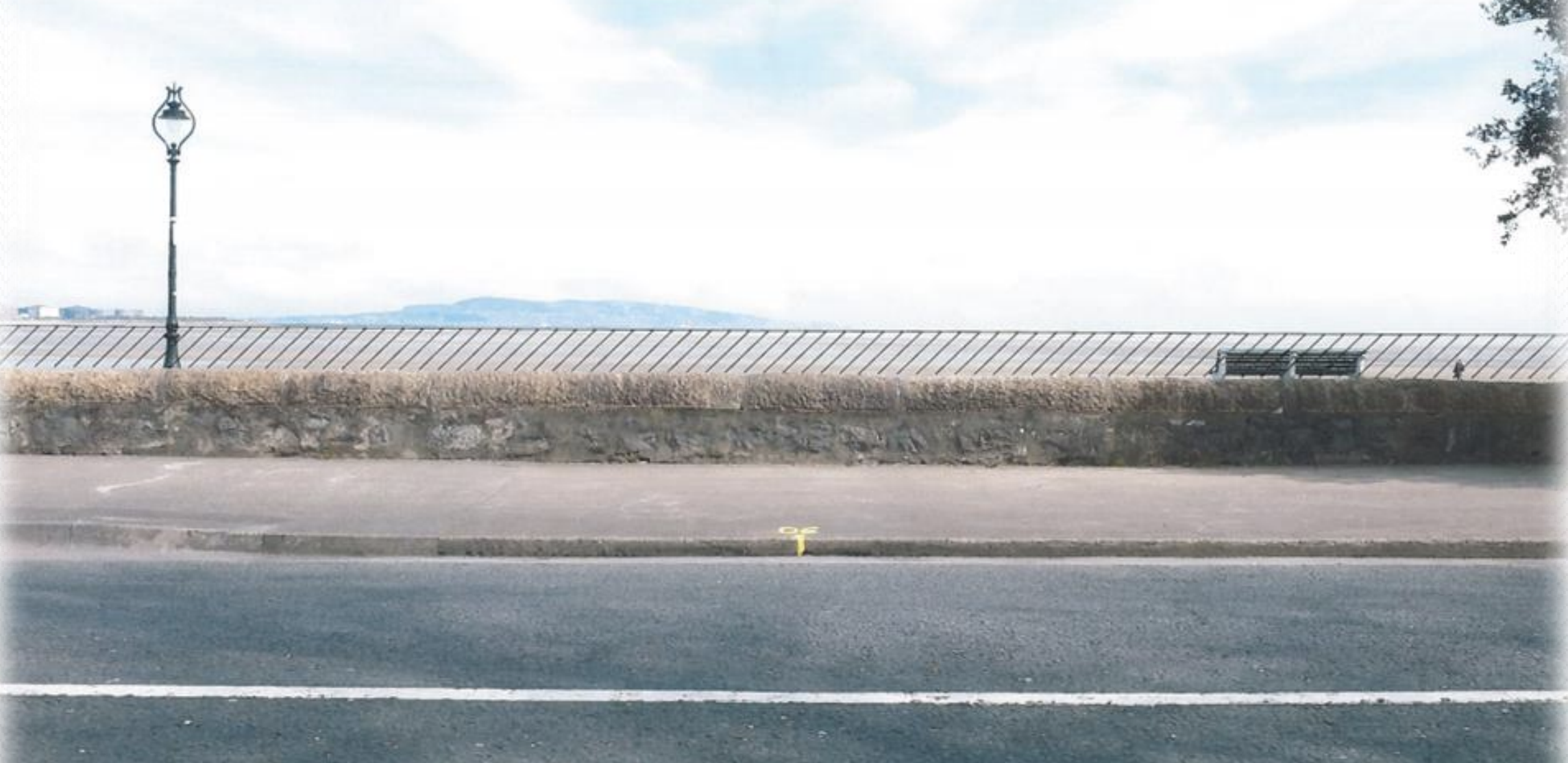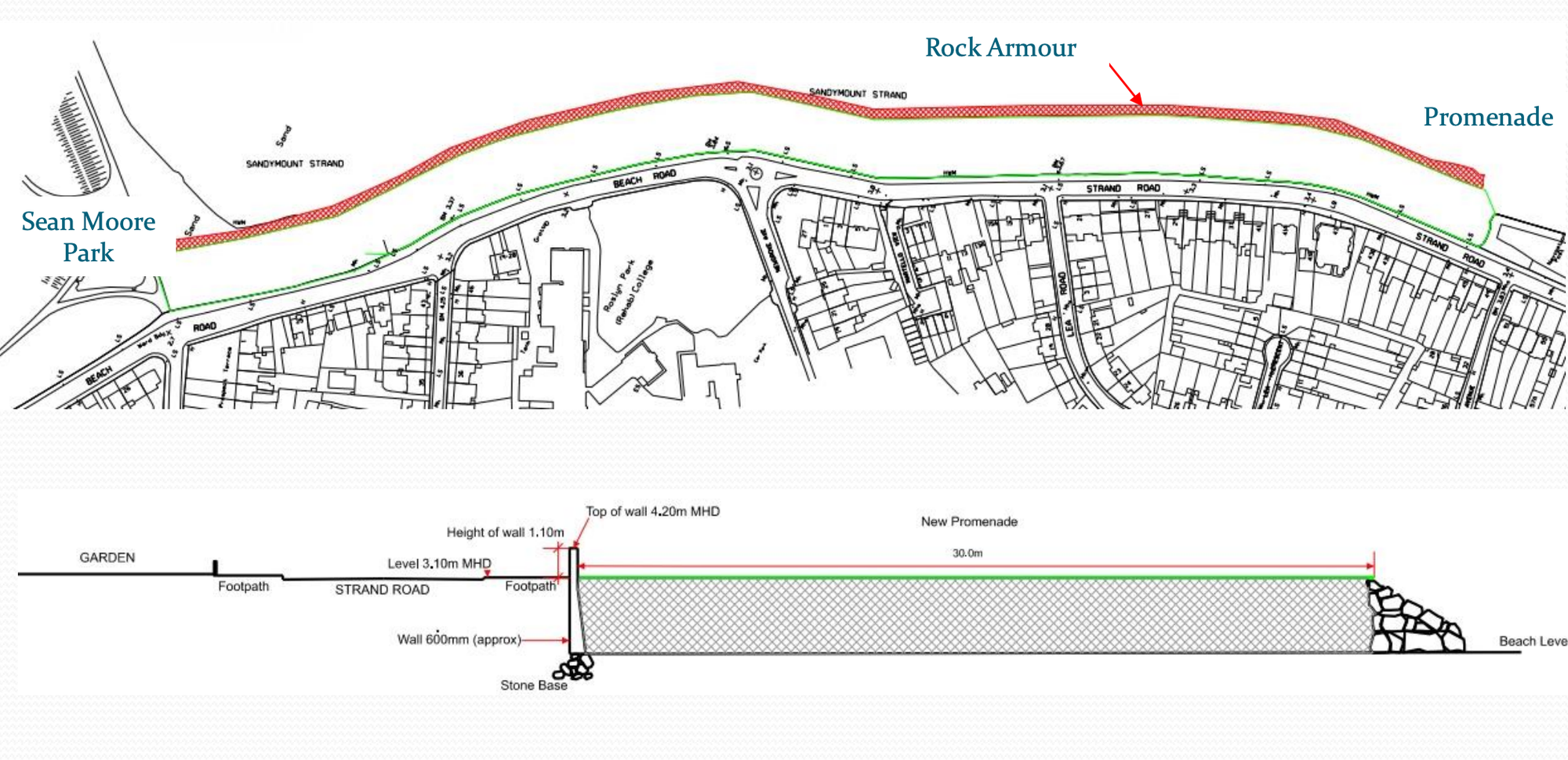What’s the best way to tell area residents about plans for a new asylum shelter nearby?
The government should tell communities directly about plans for new asylum shelters, some activists and politicians say.
These were some of the issues Dublin City Councillors discussed at recent meetings of their South East Area committee and arts and leisure committee.

Dublin City Council plans to build new flood defences in Sandymount, senior engineer Gerard O’Connell told its South East Area Committee in a presentation last week.
They’d protect Sandymount from waters 4.2 metres higher than average sea level, O’Connell said.
This is 200-year tidal flood level, plus an adjustment for climate change, plus some extra, his presentation slides say. (So, it’s meant to protect against a level that current predictions say should only happen once every 200 years.)
The plan is to start work later this year on raising the existing wall next to the footpath along the coast from St Alban’s Park north to Gilford Avenue by about 36 centimetres. It would also include installing flood gates.
This project, “phase 1”, would protect 1,200 houses from a 200-year flood, says O’Connell.

“Phase 2” would be to better protect the stretch going even further north, up to Sean Moore Park, from flooding. While Phase 1 is nearly set to go, the council is still working out its plan for phase 2.
There are four options at the moment, O’Connell said.
Option 1 is building a new wall up to 1.5 metres above footpath level with “rock armour” – a tumble of boulders – protection on the sea side. That would cost €10 million, he said.
Option 2 would be to add an 8-metre wide promenade on the sea side of the current footpath and its wall, as well as raising the wall to 1.2 metres above footpath, and including rock armour. This would cost €12.9 million, he said.
Option 3 is the same as the second option, but with a 30-metre wide promenade outside of the footpath, instead. That would cost €49 million, he said.
Option 4 is to build a 1.6-metre flood wall on the sea side of the existing sea wall, which would cost €21 million, he said.

The Sandymount area hosts about 30 different bird species, says O’Connell, and there are major environmental losses associated with the defence works.
“The environmental challenges, I would think, are as big as all of the other challenges combined, from a planning point of view,” he says. “We definitely would impact the environment.”
The council’s plan for phase 2 is to hold a public consultation in the autumn of 2022, put in a planning application in the autumn of 2024, and get a decision a year later. Construction would likely commence mid-2026, lasting until late 2028, O’Connell said.
Said Labour Councillor Dermot Lacey: “It seems to me to be an incredibly long period.”
It could be possible to shorten the construction period by six months or so, said O’Connell. “All the other steps are to do with designing, getting planning permission, and I would think that they’re all fairly rigid.”
Anne Feeney, a Fine Gael councillor, said the Sandymount cycleway project should be considered as part of this flood-defence project.
“Not to do it, and have to go back into it as a separate project, would be in my view, careless, reckless, and just really short-sighted,” she says. “It really has to be factored into this as part of the project design.”
James Geoghegan, also a Fine Gael councillor, said the 30 metre wide promenade would suit the cycleway. “In terms of, you know, the benefits it could have for the whole of the Dublin coastalway,” he says. “The NTA have to come back and seriously consider.”
O’Connell says his preferred option is the 8 metre wide promenade. “It’s mainly down to funding, I would think – what’s possible.”
There’s a plan to transform the forest cover of Dublin Mountains over the next 20 years, Daithi de Forge, head of recreation for Coillte, semi-state commercial forestry business, told the council’s arts, leisure and recreation committee on Monday.
Under the plan, the mountains would have continuous forest cover in 20 years, said de Forge. This is an initiative of the Dublin Mountains Partnership, which includes Coillte, the National Parks and Wildlife Service, Dublin City Council, South Dublin County Council, and Dún Laoghaire-Rathdown County Council.
“When you look at the Dublin mountains into the future, you won’t see the clear-felled areas any longer, you will see a continuous cover of forestry right across the hills,” he said.
Under the plans, thirty percent of the 910 hectares of forest would be transformed from spruce and conifer trees to native trees.
There have been trials in Ticknock, southwest of Sandyford, already, said de Forge.
This is a fundamental shift for Coillte, he said, “away from commercial forestry in the Dublin Mountains to native woodland, and thereby securing the Dublin Mountains in the longest term for recreation access and biodiversity”.
Connections from the city to the mountains will also be improved as part of the strategy, said Clodagh Duffy, recreation manager for the Dublin Mountains Partnership.
“We want that people can get to the Dublin Mountains without having to think you need to get into your car to do it,” she says.
“So we’re looking at sustainable walking routes, sustainable cycling routes. Then we’re also looking at public transport,” she says.
Leslie Moore, head of Dublin City Council’s parks department, says a bus route might be trialled.
A visitor counter in Ticknock recorded more than 321,000 visitors to the mountains in 2020.
As of mid-2021, that number is over 207,000. “That’s more than a full year in 2016, 17 and 18,” says Duffy.
They haven’t seen numbers drop since the pandemic began, says de Forge. “It seems that the move towards outdoor recreation is one that’s at a sustained higher level, and will continue to be in the future.”
Moore said Dublin City Council will increase its annual funding of the Dublin Mountains Partnership from €50,000 to €120,000, to employ more staff.
Failte Ireland is also on board, to create a visitor experience development plan, says de Forge.
Donna Cooney, a Green Party councillor, says the council should be wary of encouraging more people to visit the mountains.
“I know we need sustainable transport to get there, but obviously, if you get thousands and thousands of people trampling in a particular area, that can cause problems in itself,” she says.
Anne Feeney, a Fine Gael councillor, says: “I was up in Ticknock there two weeks ago again, and the reforesting piece is going ahead with, what would you say, with gusto, and I think it’s fantastic to see the spruce being replaced in many areas with native trees.”
The council plans to add columbaria to Donnybrook graveyard as part of a new strategy to make graveyards more attractive to visitors.
Labour Councillor Dermot Lacey has been calling for columbaria – walls in which to place ashes from cremations – for years, to make up for the shortage of burial space in Dublin city.
The council’s “Burial Places Strategy”, which was presented at the South East Area Committee’s meeting last week, has plans to improve 10 graveyards across the Dublin City Council area. That includes the columbarium in Donnybrook.
It also includes taking a careful look at the council’s graveyards, and writing a plan for how to get the best use out of each one.
That means protecting what’s there by, for example, keeping invasive plants out, like vines that can strangle mature trees, spread over storm-fallen trees, and cause structural damage.
It may also mean adding columbaria in other graveyards, which are full up, to get more use out of them and provide burial spaces for people in the area.
It means projects to preserve both the natural environment, and built heritage of the graveyards.
And it means making them more inviting places to visit. For example, graveyards could be developed to include remembrance garden spaces, it says.
“The strategy’s vision is to reveal the rich, often hidden, heritage of these burial places and celebrate the tangible and intangible heritage in a respectful, sustainable manner, with the aim of deepening civic pride and igniting interest in a wide range of heritage strands,” it says.
Independent Councillor Mannix Flynn said that many graveyards in the city have been removed.
“We lost the [one at] Wolfe Tone Park, and indeed we lost [the one at] St Peter’s Church there on Aungier Street, which had a substantial burial place, with Robert Emmet’s parents being buried there – and that was simply wiped off the face of the earth,” he said.
“I do think it [the strategy] really is a great leap forward,” says Flynn. “There are many such, kind of, unique burial places throughout the city,” he said.
[CORRECTION: This article was updated on 23 September 2021 to correct some of the details of the plans for trees in Dublin Mountains, including the area being planted with native trees. Apologies for the error.]
Get our latest headlines in one of them, and recommendations for things to do in Dublin in the other.